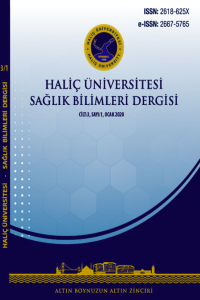Jine-onkolojik Hastalarda Kemoterapi Sürecindeki Uğraş Seçimlerinin Günlük Yaşam Aktiviteleri, Anksiyete ve Depresyon Üzerine Etkisi
Jinekolojik kanser, uğraş terapisi, anskiyete, depresyon
___
- 1. Ferlay J, Colombet M, Soerjomataram I, Mathers C, Parkin DM, Piñeros M, et al. Estimating the global cancer incidence and mortality in 2018: GLOBOCAN sources and methods. Int J Cancer. 2019; 144 (8): 1941-53.
- 2. Baxter MF, Dulworth AN, Smith TM. Identification of mild cognitive impairments in cancer survivors. Occupational therapy in health care. 2011; 25(1): 26-37.
- 3. Pekçetin S, Bumin G, Güngör T, Tunç S. Kemoterapi alan jinekolojik kanserli hastalarda algılanan aktivite performansının toplumsal katılım ve yaşam kalitesi üzerine olan etkisi. Ergoterapi ve Rehabilitasyon Dergisi. 2013; 1(2): 31–40.
- 4. Hunter E, Baltisberger J. Functional outcomes by age for ınpatient cancer rehabilitation: a retrospective chart review. Journal of Applied Gerontology. 2013; 32(4): 443–456.
- 5. Thorsen L, Gjerset GM, Loge JH, Kiserud CE, Skovlund E, Fløtten T, Fosså SD. Cancer patients' needs for rehabilitation services. Acta Oncol. 2011;50(2):212-22.
- 6. Fitzpatrick TR, Remmer J. Needs, Expectations and attendance among participants of a cancer wellness centre in montreal, quebec. Journal of Cancer Survivorship. 2011; 5(3): 235-246.
- 7. American Occupational Therapy Association. (2014). Occupational therapy practice framework: domain and process (3rd edition). American Journal of Occupational Therapy. 2014; 68: 1–48.
- 8. Bolt M, Ikking T, Baaijen R, Saenger S. Occupational therapy and primary care. Prim Health Care Res Dev. 2019; 20: e27.
- 9. Donnelly C, Brenchley C, Crawford C Letts L. The emerging role of occupational therapy in primary care. Canadian Journal of Occupational Therapy. 2014; 81: 51–61.
- 10. Wong SR & Fisher G. Comparing and using occupation focused models. Occ Therap Healtcare. 2015; 29(3): 297-315.
- 11. Tinelly M Byrne M. Primary care occupational therapy: exploring the perceptions of therapists’ role and their current practice in Ireland. Irish Journal of Occupational Therapy. 2016; 44:23–31.
- 12. Ikiugu MN & Nissen RM. Intervention strategies used by occupational therapists working in mental health and their theoretical basis. Occupational Therapy in Mental Health. 2016; 32(2): 109-129.
- 13. Arbesman M, Lieberman D, & Metzler CA. Using evidence to promote the distinct value of occupational therapy. American Journal of Occupational Therapy. 2014; 68: 381–385.
- 14. Ikiugu MN. Use of theoretical conceptual practice models by occupational therapists in the US: A pilot survey. International Journal of Therapy and Rehabilitation. 2012; 1(11): 629–636.
- 15. Zigmund AS, Snaith RP. The hospital anxiety and depression scale. Acta Psychiatr Scand. 1983; 67:361-370.
- 16. Aydemir Ö, Güvenir T, Küey L. Validity and realibility of Turkish version of hospital anxiety and depression scale. Turkish Journal of Psychiatry. 1997; 8:280-287.
- 17. Katz S, Ford AB, Moskowitz RW, Jackson BA, Jaffe MW. Studies of illness in the aged. The Index of ADL: A standardized measure of biological and psychosocial function. JAMA. 1963; 185:914-19.
- 18. Kaya E, Özbek S, Tekin A, Ergin S, Yaman A. KOAH’lı yaşlı hastalarda günlük yaşam aktivitelerinin değerlendirilmesi. Turkish Journal of Geriatrics. 2010; 13(2): 111-116.
- 19. Hahn C, Dunn R, Halperin E. Routine screening for depression in radiation oncology patients. Am J Clin Oncol. 2004; 27: 497–499. 20. Çokmert S, Yavuzşen T, Ünek İ. Ayaktan Tedavi Gören Kanser Hastalarının Kemoterapi Sırasında Uğraşı Seçimleri, ACU Sağlık Bil Derg. 2011; 2(1):31-36.
- 21. Riley RG, Manias E. The uses of photography in clinical nursing practice and research: a literature review. J Adv Nurs. 2004; 48: 397-405.
- 22. Stuckey HL, Nobel J. The connection between art, healing, and public health: a review of current literature. Am J Public Health. 2010; 100: 254-63.
- 23. Ferrer AJ. The eff ect of live music on decreasing anxiety in patients undergoing chemotheraphy treatment. J Music Ther 2007; 44(3): 242–255.
- 24. Mustian KM, Sprod LK, Janelsins M, Peppone LJ, Palesh OG, Chandwani K, Morrow GR. Multicenter, randomized controlled trial of yoga for sleep quality among cancer survivors. Journal of Clinical Oncology. 2013; 31(26): 3233–3241.
- 25. Silver JK, Gilchrist LS. Cancer rehabilitation with a focus on evidence-based outpatient physical and occupational therapy interventions. American Journal of Physical Medicine & Rehabilitation. 2011; 90(5): 5-15.
- 26. Lattanzi JB, Giuliano S, Meehan, C, Sander B, Wootten, R, Zimmerman A. Recommendations for physical and occupational therapy practice from the perspective of clients undergoing therapy for breast cancer-related impairments. Journal of Allied Health. 2010; 39(4): 257-264.
- 27. Pergolotti M., Williams G. R., Campbell C., Munoz L. A., Muss H. B. Occupational therapy for adults with cancer: Why it matters. Geriatric Oncology. 2016; 21: 314–319.
- 28. Hinojosa J. The evidence-based paradox. American Journal of Occupational Therapy. 2013; 67:18-23.
- 29. Tomori K., Nagayama H., Ohno K., Nagatani R., Saito Y., Takahashi K., Higashi T. Comparison of occupation-based and impairment-based occupational therapy for subacute stroke: A randomized controlled feasibility study. Clinical Rehabilitation. 2015; 29(8): 752–762.
- ISSN: 2618-625X
- Yayın Aralığı: Yılda 3 Sayı
- Başlangıç: 2018
- Yayıncı: Haliç Üniversitesi
Kürek Sporuna Yeni Başlayanlarda Slide Board Egzersizlerinin Max vo2 Etkisinin İncelenmesi
Murat TÜRKER, Menşure AYDIN, Bergün MERİÇ BİNGÜL, Çiğdem BULGAN, Nalan SUNA
Ağır Metal İşçilerinde Yorgunluk Düzeyinin Plantar Basınç Dağılımına Etkisinin İncelenmesi
Gülay ARAS BAYRAM, Gözde KESİKBAŞ
Gebelerin Doğumda Ebelerden Beklentileri
Selda İLDAN ÇALIM, Hülya DEMİRCİ, Seval CAMBAZ ULAŞ
COVİD-19 PANDEMİSİ ve KADINLAR
Esra ÜNAL, Derya ATİK, Ebru GÖZÜYEŞİL
İRRİTABL BARSAK SENDROMUNUN KİŞİLİK ÖZELLİKLERİ İLE İLİŞKİSİ
Adile BOZKURT, Derya ATİK, Ayşe İNEL MANAV
